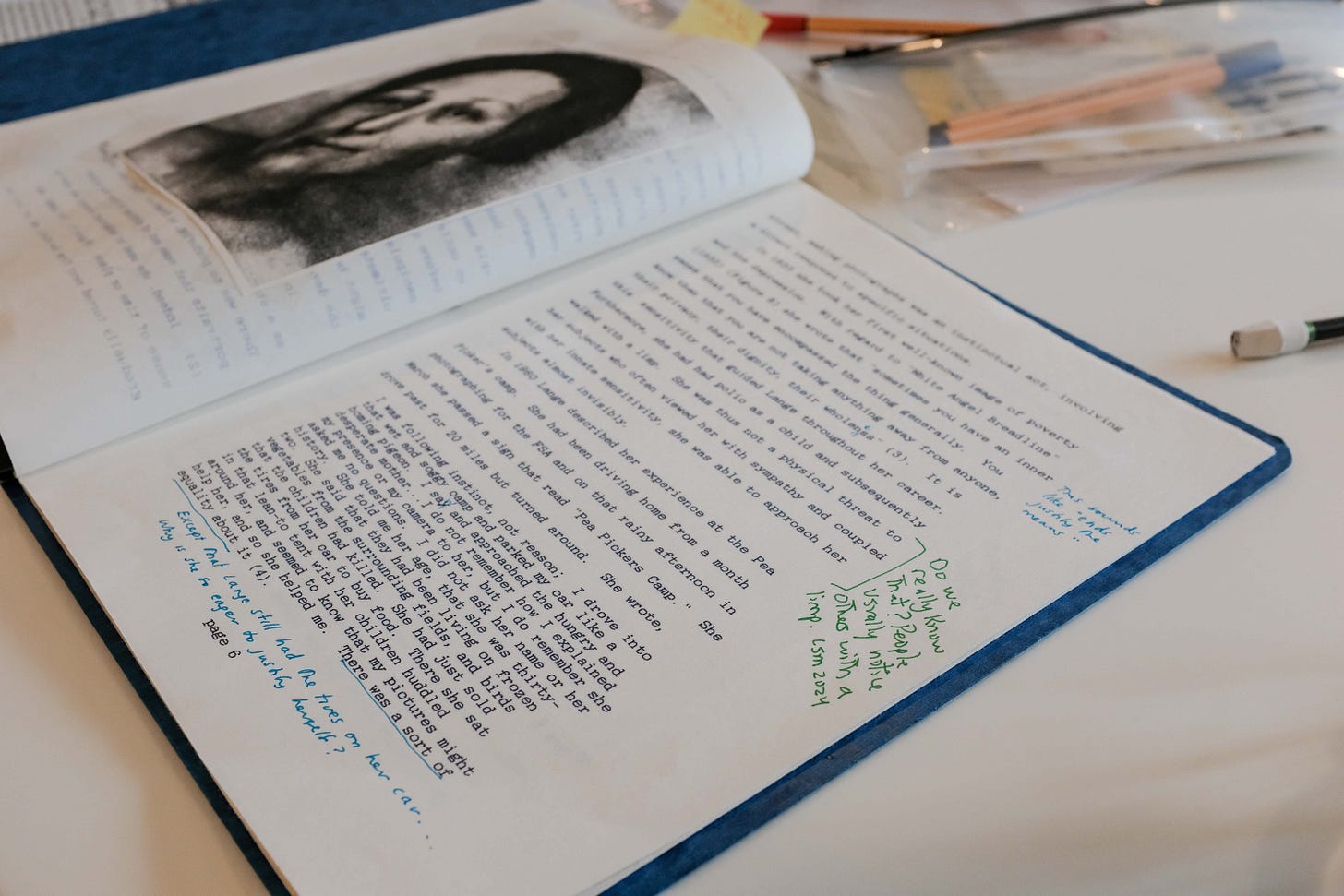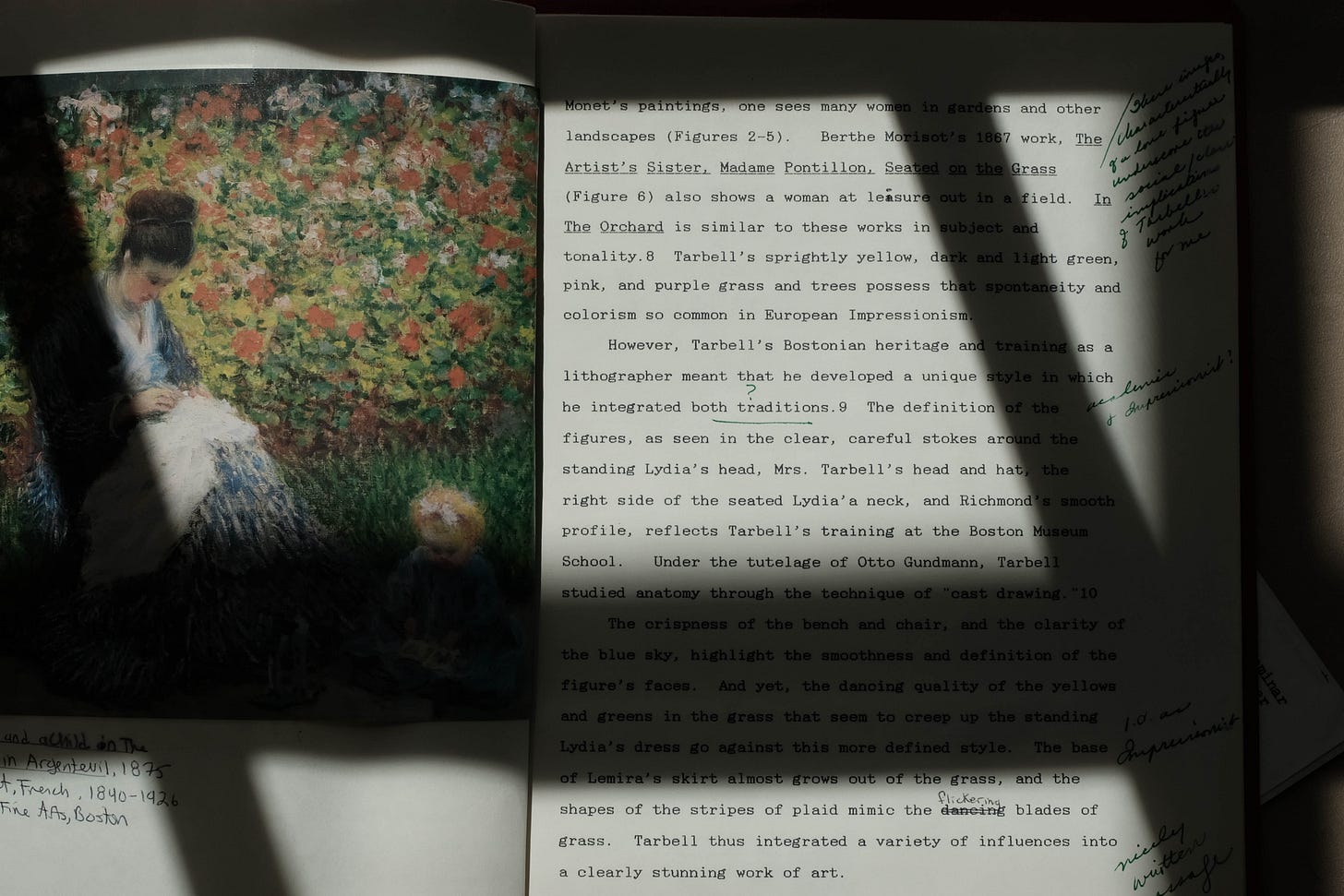Annotations
notes of explanation, comments added and so much more...
Hello Dear Readers,
What’s a person to do with college essays and class notes archived in the attic for decades?
If you are me or my partner, you might spend a hot 4th of July weekend drinking iced tea and re-reading them…piles of them…
…and re-discovering what a dedicated student you were…
…and wondering what compelled you to save all of this work in the first place.
Humm. Was it, perhaps, an underlying sense of self-importance, saving evidence for our future biographers?1
While in college and graduate school, he investigated the nuances of chemistry and medicine and I explored important topics, like kinship, narrative and the significance of tolerance and reciprocity - - Funny enough, all things I still think about.


But by the time we’d filled an entire 50 gallon recycling bin, we wondered if it actually had more to do with a need to honor all the life energy we had put into every class we had ever taken, whether in elementary, middle and high school, college, or graduate school.
I mean, check out this geography project from 6th grade…
…or this illustrated essay on Edmund C. Tarbell’s painting In The Orchard. Talk about effort!
But it is the annotations, made by teachers long ago, that intrigue me the most.


It’s one thing to comment on all the work I did. It is quite another to acknowledge the effort others put into my education, explaining why a certain test response wasn’t quite up to par or editing my papers to ensure I improved my grammar.2
Annotations: Notes of explanation or comments added.
Really, though, annotations are a collaborative conversation between two or more people - - sometimes at a given moment, as with these high school history tests or college essays, and others over a more extended period of time, as happened for me last week…
Check out how the TA commented on my presumption of rapport between photographer and subject in Dorothea Lange’s Migrant Mother.3 I wonder what they scratched out in blue?4
I loved responding to what he wrote in blue with my own green markings.
This conversation about the Migrant Mother, initially only with myself and contained within the essay, came to life when I received Collaboration A Potential History of Photography, a shared project through the Kinship Photography Collective.5
Three kinship photographers had already read and annotated the book when it arrived on my front porch a few weeks ago. After spending time with the annotations they had made and reading much of this complex narrative, I got to work, using velum and other supplies to respond to the section of the book on Dorothea Lange and the Migrant Mother.
As the title suggests, Collaboration A Potential History of Photography the premise of the book is collaboration and the degree to which photographers and their subjects are acknowledged co-creators or not.
The authors invite us to rethink the objectification of subjects in photographs, and the irony that an individual, like Florence Owens Thomson (THE Migrant Mother), can become a symbol, perhaps aiding others, but not necessarily getting credit or benefiting in any way.
All of which leads me to think about this question of credit, whether it’s earning a grade for an essay or having your name associated with an image you’ve created.
My more magnanimous self might ask, “why does getting credit matter if the work is doing whatever I wanted it to do in the world?” But my more honest self acknowledges that when I put effort into a thing, whatever it may be, it is more enriching when shared with others in the creation of something larger than the thing itself.
Yikes, this is sounding academic - - Funny, given what I’m writing about!6
Anyway, back to this collaborative project.
I’d been feeling intense grief about all those piles of papers and notes thrown into the recycling bin, but this project ignited something else.
When I copied some of the annotated parts of the essay onto the velum, I experienced a thrilling sense of freedom.
Suddenly all these pages and words I’d held onto for decades transformed from objects for which I was responsible, to living and breathing parts of myself.
“Oh, right,” I said to the dogs. “This is just more compost, only in a different form.”
It’s all about process, isn’t it?
…And accumulations of experiences, knowledge and other stuff needing to be ‘processed’ one way or another.
Just as the images in Collaboration A Potential History of Photography are being examined in a new way, so too am I shaking things up a bit by deconstructing my own writing from an earlier time.
Yup. Definitely compost - - a mix of this and that, turned and integrated into a garden.
But this garden contains photographs, people and ideas cultivating kin with respect, tolerance, and deep reciprocity.7
And in this particular case, the processed ‘compost’ contains annotations on pages becoming part of a dynamic and evolving conversation between subject matter and student, student and teacher, student and teacher and a book decades later and finally, that book and other artists creating a completely new, annotated work.
By the time I’d finished my part of this project and sent the book to the next person in our kinship group, I was deeply curious about what would emerge…and wondering about building community by sharing annotations of all kinds…So much to consider.
Would you ever join an annotated book group, for example? Let me know by leaving a comment.
Cultivating community through annotations also makes me wonder how 13 Tons of Love might evolve into an annotated collaborative community…who knows what that might look like!8
It might begin with sending links to this and other posts with people you think might be interested in this sort of thing…and including a note of some kind explaining why you wanted to share.
As always, thank you for being here and sharing your time and this space with me.
With gratitude for you being you,
Lyn
D and I were, after all, among the ‘best and the brightest’ students, both attending Ivy League universities in the 1980’s. I say this tongue and cheek, though, as he and I were worker bees - - Inspired and motivated, but needing to actually do the work (unlike some of our more brilliant classmates for whom the path was a much smoother ride).
My sister, Sarah Swett, creator of The Gusset, reminded me the other day that I am doing my biographers a great favor by getting rid of all this extra reading material, whether old tax returns or financial statements or notes from college classes. “Let them focus on your current work and words. They are much more interesting and powerful.” And then we both laugh, because, in fact, when you are descended from people who have books written about them, you tend to think that having someone write about you is a real possibility.
We both agree, however, that we’d much rather curate our own narratives than have anyone else dare to interpret us! That, I imagine, is why we both write on Substack!
These tests were from US history in 11th grade (1982-83). It was a turning point for me, when I learned how to write more clearly, especially in response to test questions. And what a surprise to see that I earned a B-/C+ - - I don’t remember doing that very much, though I don’t remember many A’s in high school either. For me, it was all about effort.
To learn more about Lange’s Migrant Mother series, check out this Library of Congress guide.
This is from a page in my essay “Dorothea Lange’s Migrant Mother Series: A Dramatic Portrait,” written for a class called The Portrait with Professor Henri Zerner. It was a huge lecture class so these annotations must have been made by the teaching assistant who ran my particular “Section.”
As part of this year’s theme, Between Bodies, we are exploring different kinds of connection and collaboration. In addition to considering images that are part of a ‘body’ of work, we are experimenting with collaborative creation in the form of a shared annotated book. It needs no explanation that the book we are annotating together is Collaboration A Potential History of Photography.
In case you haven’t noticed, I have a tendency to get serious. I wonder what will happen now that I’ve let go of all these pages?
This moving process is fascinating…an invitation to melancholy but also part of a larger process of letting go and treading more lightly. We’ll have to stay tuned to see what happens, won’t we?
I am in awe that these words jumped out from my thousands of pages of notes…You never know where the original seed for an idea came from.
As mentioned in the ‘please subscribe’ note at the bottom of this post, September will be the 1 year anniversary of my starting 13 Tons of Love. I am excited to share what emerges next after we move and I take a holiday in August.

















